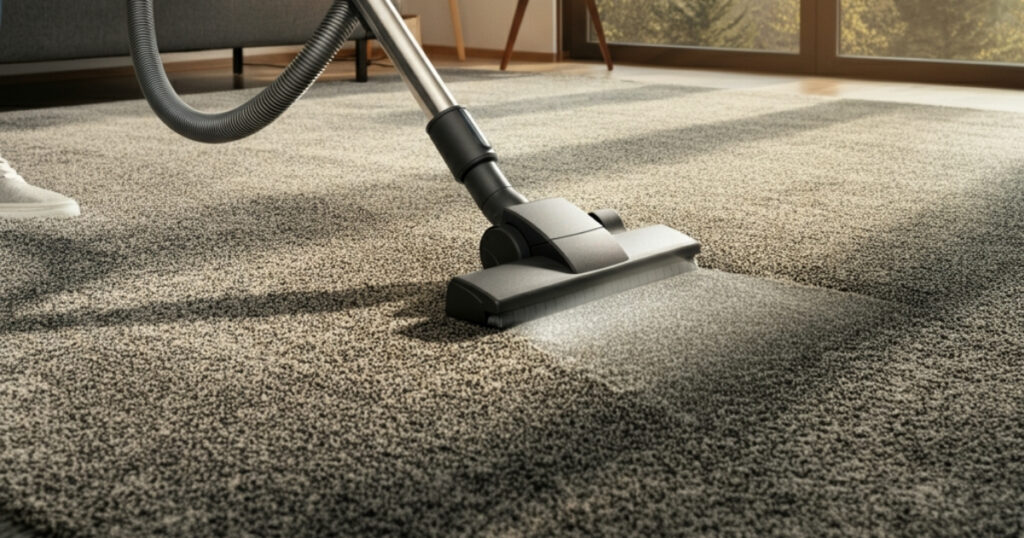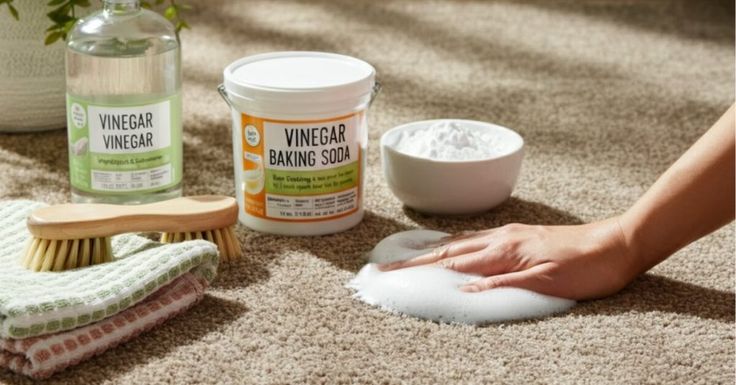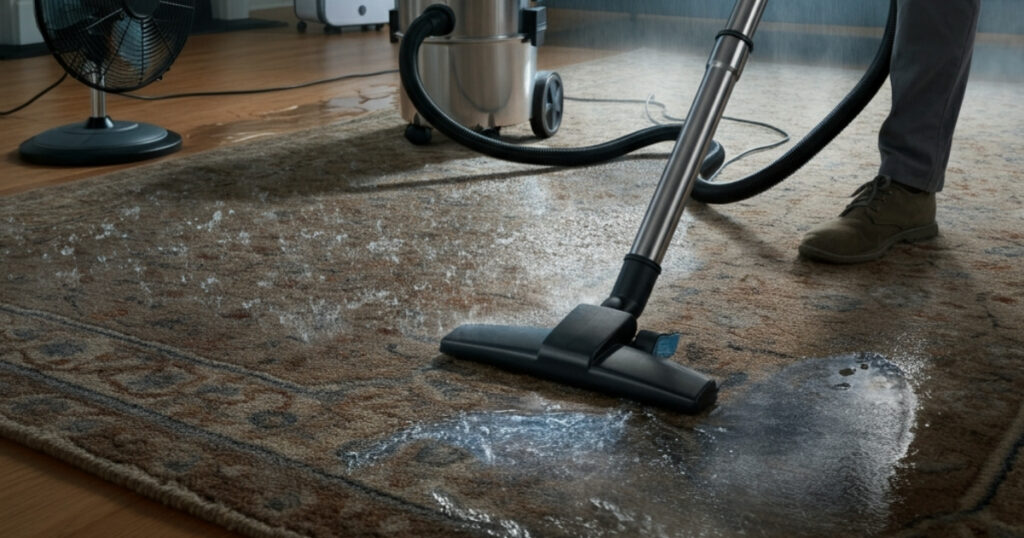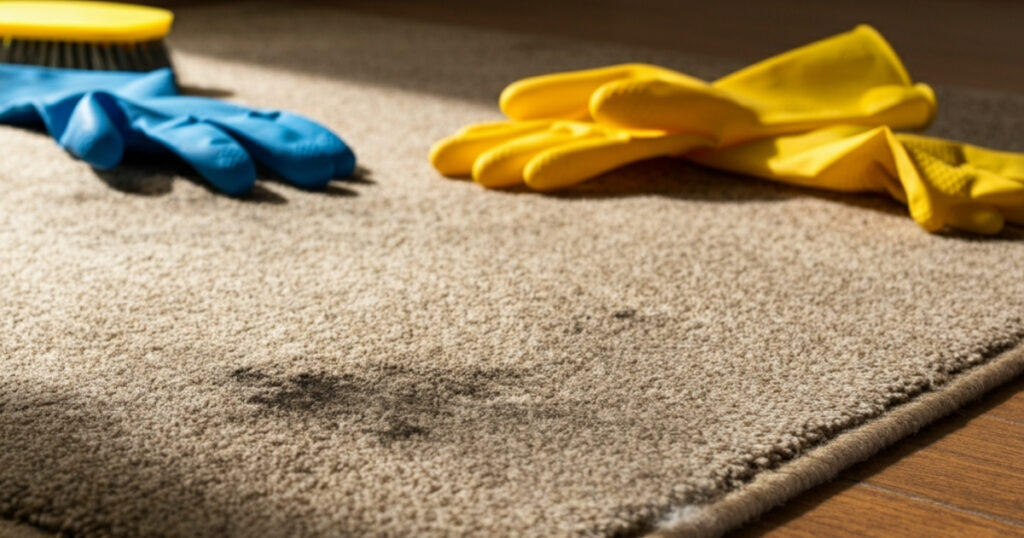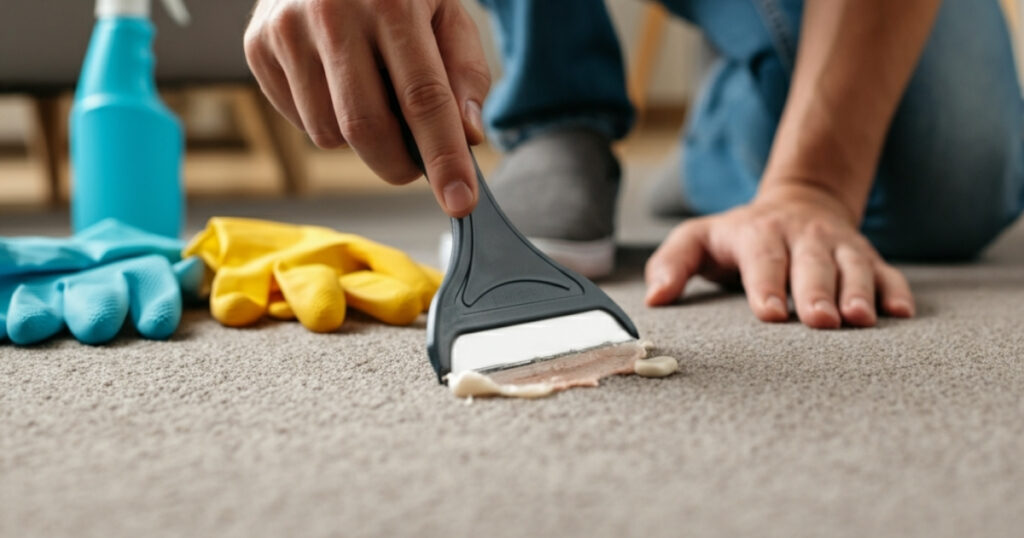As an Amazon Associate, I earn from qualifying purchases.
Finding mold in your carpet is more than just an unsightly problem; it can also pose health risks and indicate a larger moisture issue in your home. If you’re wondering how do you clean mold out of carpet, you’ve come to the right place. Acting quickly and using the correct cleaning methods are essential to protect both your carpet and your family’s health.
This comprehensive guide provides a step-by-step approach to safely and effectively remove mold from your carpet. We will cover how to identify mold, the necessary safety precautions, and several cleaning methods using common household products. Furthermore, we’ll explore when it’s time to call in a professional and how to prevent mold from returning. By following these instructions, you’ll be equipped to handle a mold problem with confidence and restore a healthier environment in your home.
Contents Overview
How to Identify Mold in Your Carpet
Before you can tackle the problem, you need to be sure you’re dealing with mold. Mold can often be mistaken for simple dirt or a stubborn stain. Here’s what to look for when inspecting your carpet.
Visual Signs of Mold
Mold growth on a carpet can appear in various colors, including black, green, white, or even pink. It often grows in circular patches and may have a fuzzy or slimy texture. You might notice discoloration on the surface of the carpet that doesn’t come out with regular cleaning. In some cases, mold grows on the carpet padding or subfloor, making it less visible. If you suspect mold but don’t see it, carefully lift a corner of the carpet in the affected area to inspect the backing and padding underneath.
Musty Odor
One of the most telling signs of mold is a persistent musty smell. This odor is caused by microbial volatile organic compounds (MVOCs), which are gases produced by the mold. Even if you can’t see the mold, a strong, earthy smell that won’t go away, especially in a damp or poorly ventilated area, is a significant red flag. Don’t ignore this scent, as it almost always indicates the presence of mold or mildew.
Safety First: Prepare for Mold Removal
Cleaning mold requires handling substances that can be harmful if inhaled or touched. Protecting yourself is the most important step before you begin. Mold spores can easily become airborne during the cleaning process and can cause respiratory issues, allergic reactions, and other health problems.
Gear Up for Safety
Before you start, gather the following personal protective equipment (PPE):
- N-95 Respirator Mask: This will prevent you from inhaling airborne mold spores.
- Safety Goggles: Protect your eyes from spores and cleaning solutions.
- Long Rubber Gloves: Keep your hands safe from contact with mold and harsh chemicals.
- Old Clothing: Wear long sleeves and pants that you can either wash in hot water immediately after or dispose of.
Ventilate the Area
Proper ventilation is crucial to disperse mold spores and chemical fumes.
- Open all windows and doors in the room to create cross-ventilation.
- Use fans to direct air out of the windows, but avoid pointing fans directly at the moldy area, as this can spread spores to other parts of your home.
- If the affected area is in a bathroom or kitchen, use the exhaust fan.
How to Clean Mold Out of Carpet: A Step-by-Step Guide
Once you’re prepared with the right safety gear, you can begin the cleaning process. This guide covers a few different methods using common household items. Always start with the gentlest method first.
Step 1: Dry the Affected Area
Mold thrives in moisture, so your first step is to dry the carpet completely. If the carpet is damp or wet, use a wet-dry vacuum to extract as much water as possible. For smaller damp spots, you can use towels to blot the area dry. Place fans or a dehumidifier near the spot to speed up the drying process. Do not proceed with cleaning until the carpet is completely dry to the touch.
Step 2: Vacuum the Moldy Area
After the carpet is dry, it’s time to remove the surface mold spores.
- Use a vacuum cleaner with a HEPA (High-Efficiency Particulate Air) filter. A HEPA filter is essential because it can trap tiny mold spores and prevent them from being blown back into the air.
- Thoroughly vacuum the surface of the moldy patch.
- Once finished, take the vacuum outside to empty the canister or dispose of the bag to avoid releasing spores inside your home.
Method 1: Using White Vinegar and Baking Soda
This natural and effective method is a great starting point for cleaning mold.
- Create the Cleaning Solution: Fill a spray bottle with undiluted white vinegar. Vinegar is a mild acid that can kill many common types of mold.
- Apply the Vinegar: Lightly spray the vinegar directly onto the moldy area of the carpet. Be careful not to oversaturate it, as excess moisture can encourage more mold growth. Let the vinegar sit for about an hour to penetrate the fibers and kill the mold.
- Apply Baking Soda: After the vinegar has sat, sprinkle a generous amount of baking soda over the area. Baking soda will help absorb the remaining moisture, neutralize the musty odor, and lift the mold from the carpet fibers.
- Scrub the Area: Use a stiff-bristled brush to scrub the baking soda into the carpet. You should see the mold begin to lift.
- Vacuum Again: Let the baking soda sit until the area is completely dry, then vacuum thoroughly with a HEPA-filtered vacuum to remove all residue.
Method 2: Using Dish Soap and Water
For very small or light mold spots, a simple soap and water solution can be effective.
- Mix the Solution: In a small bowl, mix a teaspoon of mild dish soap with two cups of cool water.
- Blot the Stain: Dip a clean cloth into the soapy water and gently blot the moldy area. Work from the outside of the stain inward to prevent it from spreading. Avoid rubbing, as this can damage carpet fibers.
- Rinse the Area: Dampen a new, clean cloth with plain water and blot the area to rinse out any soap residue.
- Dry Completely: Press a dry towel firmly onto the spot to absorb as much moisture as possible, then allow it to air dry completely.
Method 3: Using a Professional Mold Killer
For more stubborn mold, you may need a commercial carpet cleaner specifically designed to kill mold.
- Choose the Right Product: Look for a product that is approved for use on carpets and is an EPA-registered fungicide.
- Follow the Instructions: Read and follow the manufacturer’s instructions carefully. Always perform a spot test on a hidden area of the carpet first to ensure it doesn’t cause discoloration.
- Apply and Clean: Apply the product as directed, let it sit for the recommended time, and then scrub and blot as instructed.
- Dry the Carpet: Ensure the carpet is completely dry after cleaning to prevent the mold from returning.
What to Avoid When Cleaning Carpet Mold
Some common cleaning agents can do more harm than good when it comes to mold on carpets.
- Bleach: While bleach is a powerful disinfectant, it is not recommended for cleaning mold on porous surfaces like carpets. The chlorine in bleach cannot penetrate deep into the fibers to kill the mold’s roots, and the water content in bleach can actually feed the remaining mold. Bleach can also discolor or damage carpet fibers.
- Steam Cleaner: Avoid using heat on mold. A steam cleaner can set the mold stain permanently into the carpet and the moisture can encourage regrowth.
When Should You Call a Professional?
While DIY methods can be effective for small mold spots, some situations require professional intervention.
- Large Infestations: If the mold covers an area larger than 10 square feet, it’s too big to handle safely on your own.
- Carpet Padding is Affected: If the mold has penetrated the carpet backing and into the padding or subfloor, the carpet and padding will likely need to be replaced.
- Black Mold: If you suspect you have black mold (Stachybotrys chartarum), do not attempt to remove it yourself. This type of mold is highly toxic and requires professional remediation.
- Recurring Mold: If the mold keeps coming back after you clean it, there is likely an underlying moisture problem that a professional needs to address.
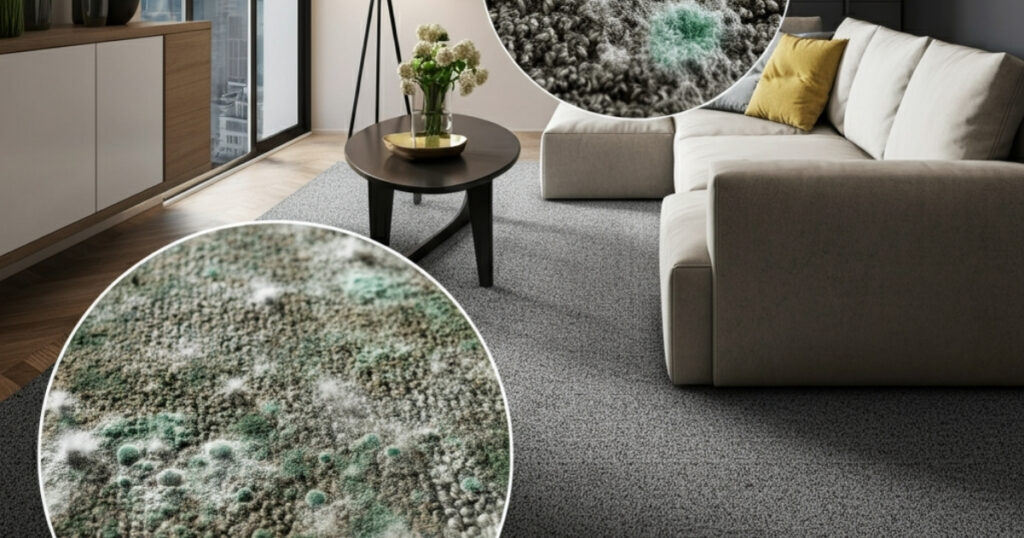
Frequently Asked Questions (FAQs)
1. Is it safe to clean mold from my carpet myself?
Yes, it is generally safe to clean small areas of mold (less than 10 square feet) yourself, provided you wear the proper personal protective equipment (PPE), including an N-95 mask, goggles, and gloves.
2. Will cleaning mold out of my carpet kill all the spores?
No, cleaning will remove the visible mold and kill many of the spores, but it’s nearly impossible to eliminate all of them. The key is to remove the moisture source to prevent the remaining spores from growing.
3. Can I just use baking soda to clean carpet mold?
Yes, baking soda is great for absorbing moisture and odors, but it doesn’t kill mold as effectively as vinegar. It’s best used in combination with vinegar for a more powerful cleaning solution.
4. How do I know if my carpet is too moldy to save?
No, if the mold has soaked through to the carpet padding and subfloor, or if the moldy area is very large, the carpet is likely unsalvageable and should be professionally removed and replaced.
5. What causes mold to grow in carpet in the first place?
Yes, mold grows in carpet due to excess moisture. Common causes include leaks, high humidity, flooding, or spills that weren’t dried properly. Mold needs moisture, a food source (the carpet fibers), and the right temperature to grow.
A Healthier Home Starts with a Clean Carpet
Discovering mold in your home can be alarming, but it doesn’t have to be a disaster. By understanding how do you clean mold out of carpet and taking swift action, you can effectively manage the problem. Remember to prioritize safety, address the source of the moisture, and don’t hesitate to call a professional for large or persistent mold issues. With the right approach, you can restore your carpet and ensure your home remains a healthy place for you and your family.
As an Amazon Associate, I earn from qualifying purchases.

